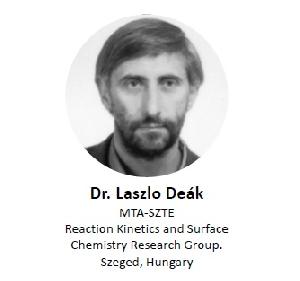


Aula 23H. Dpto. Física-UNS. Viernes 26/10. 16:30hs.
Dr. Laszlo Deák
MTA-SZTE
Reaction Kinetics and Surface
Chemistry Research Group.
Szeged, Hungary
Activation of small molecules on oxides and oxide-metal interfaces
The catalytic activation of small molecules, like CO, H2O and H2 is of importance in different processes, such as hydrogenation of CO and water gas shift reaction, for which metal oxide supported rhodium catalysts are widely applied. The critical role of metal particle-oxide interface in activating small molecules was established under high pressure conditions , but have rarely been addressed by UHV model studies. We have studied the impact of rhodium-titania and Rh-molybdena interfaces on the CO and H2O decomposition by AES, ISS, STM, XPS, TPD and sensitive temperature-programmed work function (WF) measurements.
The TiOx overlayers were formed by annealing the TiO2(110) supported rhodium, while the atomically thin MoOx deposits by the oxidation of Mo. Both oxides exerted inhibition effect on the molecular bonding of CO, which, however, was accompanied by considerable promotion of CO dissociation, maximized at 0.2-0.3 ML oxide coverages. The MoOx overlayer, having much lower surface free energy than the atomically thin TiOx film, completely covered the Rh particles by annealing to 650 K and eliminated the CO adsorption capability of the surface. On the contrary, the titania supported Rh particles showed the maximum CO dissociation propensity after annealing to 700 K. The maximization of CO decomposition is straightforwardly associated with the active role of metal particle-oxide interfaces. Desorption peak temperature for the associative CO desorption on the MoOx modified Rh particles (Tp=700 K) suggests a lower activation energy in the recombination reaction of Oa and Ca atoms, than that for the TiOx covered surfaces (Tp=800 K) which allows higher reaction rates for these intermediates in the former case. Our UHV study is in harmony with the results of high pressure experiments, concerning the formation of carbon intermediate from CO dissociation during CO methanation.
The reactions of water showed variety with the extent of reduction of titania support. Strongly reduced surfaces produced H2O and H2 desorption states with Tp=370 and 470 K, corresponding to recombinative and dissociative reaction paths of the surface OH moieties. The interaction of water with the Rh-TiOx interface was characterized with a H2 desorption state at 580 K, arising from OH groups exhibiting maximal population at intermediate TiOx coverages. The concomitant operation of inhibition and promotional effects of metal oxide overlayers on the adsorption properties of a metal could be rationalized with a simple island model. Some extreme hydrogen dissolution properties of a strongly reduced, black titania crystal have also been revealed.